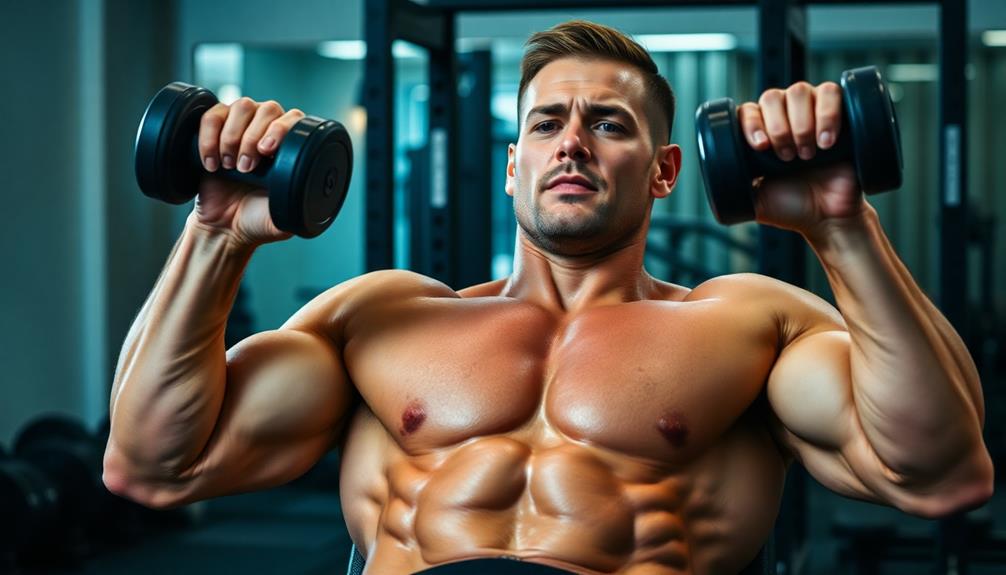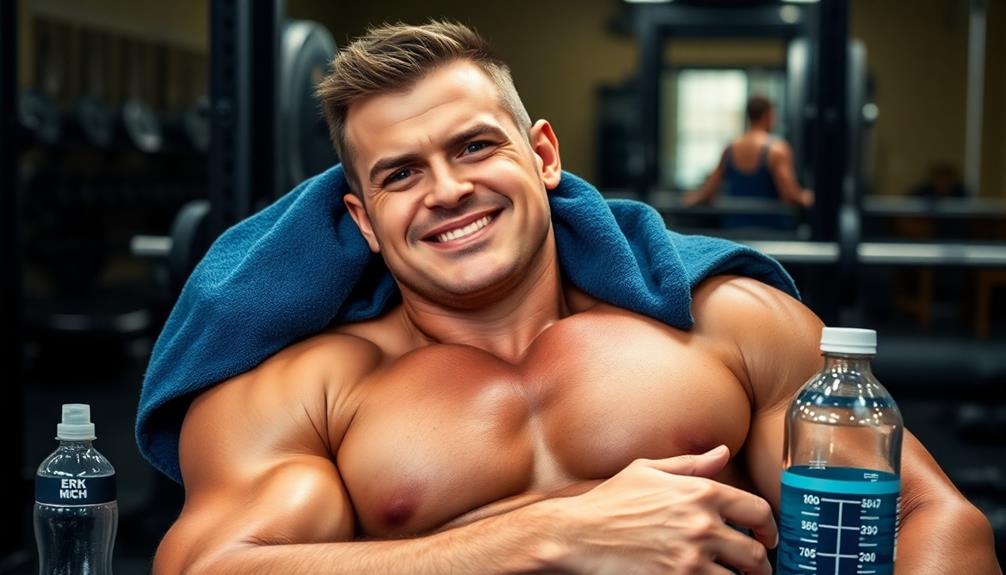To master upper body hypertrophy, you'll need a strategic approach. Start by understanding muscle growth principles and selecting effective exercises for each muscle group. Focus on proper form and technique to maximize results and prevent injuries. Incorporate a mix of compound and isolation movements, using both free weights and machines. Aim for 8-12 reps per set, performing 3-4 sets for each exercise. Prioritize nutrition, ensuring adequate protein intake and hydration. Don't forget the importance of rest and recovery for muscle repair and growth. Consistency is key, so stick to your plan and track your progress. The following guide will provide a detailed roadmap for your hypertrophy journey.
Core Insight
- Focus on compound exercises targeting multiple muscle groups for efficient upper body growth.
- Progressively increase weight, sets, or reps to continually challenge muscles and promote hypertrophy.
- Maintain proper form and technique to maximize muscle engagement and prevent injuries.
- Incorporate a variety of exercises for each muscle group to stimulate growth from different angles.
- Prioritize adequate rest, nutrition, and hydration to support muscle recovery and growth.
Understanding Muscle Hypertrophy

Muscle hypertrophy means making your muscles bigger by growing the muscle fibers you already have. When you lift weights, you create tiny tears in your muscle fibers. As your body fixes these tears, it makes the muscles stronger and bigger. Taking supplements like HMB can help by increasing muscle protein production and reducing muscle breakdown.
There are two main types of hypertrophy: sarcoplasmic and myofibrillar. Sarcoplasmic hypertrophy increases the fluid in muscle cells, while myofibrillar hypertrophy grows the actual muscle fibers. Both types help your muscles get bigger.
To make your muscles grow, you need to focus on specific things in your workouts, like how much you lift, how hard you lift, and how often you lift. You also need to eat right and get enough rest to support muscle growth. By understanding these basics, you can create workouts that will help you build muscle in your upper body.
Key Principles of Upper Body Training

To get the most from your upper body workouts, remember these key points. First, keep pushing yourself by slowly increasing the amount of weight you lift, how often you lift, or the number of times you do each exercise. This will make your muscles work harder and grow bigger over time. Adding protein powder to your diet can also help your muscles recover and grow. Whey protein is a great choice because it has all the amino acids your body needs.
Second, always use the right form when lifting. This means focusing on using the right muscles for each exercise and lifting safely to avoid getting hurt. Even if you can't lift as much weight, using good form is more important.
Exercise Selection for Maximum Growth

To build muscle effectively, choose a combination of compound and isolation exercises for each muscle group. For chest, do bench presses along with flyes or cable crossovers. Work your back with pull-ups, rows, and lat pulldowns. Shoulder exercises should include overhead presses, lateral raises, and face pulls. Hit your triceps with close-grip bench presses and pushdowns, and focus on curls and chin-ups for biceps. Use both free weights and machines to target muscles from various angles. Select exercises that let you safely lift heavy weights, as this is key for muscle growth. To speed up recovery and reduce soreness, try foam rolling after your workouts. This boosts blood flow and eases muscle tension, helping you perform better in future sessions. Tailor your exercise choices based on your individual strengths, weaknesses, and any physical limitations you may have.
Proper Form and Technique

Proper form and technique are essential for an effective upper body workout. When doing exercises, keep your core tight and focus on the muscles you're working. For chest exercises, keep your shoulders back and squeeze your chest at the top of each rep. When working your back, pull with your elbows and focus on squeezing your shoulder blades together. For shoulder exercises, keep your elbows slightly bent and avoid swinging. When training arms, keep your elbows close to your body for bicep curls and tricep extensions. Always control the lowering phase of each exercise, as this is important for muscle growth. To help your recovery and keep your muscles flexible, consider using foam rollers after your workout for self-massage. Remember to breathe steadily, breathing out as you lift the weight and breathing in as you lower it.
Optimal Rep Ranges and Sets

To grow your muscles effectively, it's key to use the right number of reps and sets in your upper body workout. For muscle growth, do 8-12 reps per set. Focus on controlled movements with a moderate amount of weight. Aim for 3-4 sets for each exercise to really stimulate your muscles.
Here's a solid way to structure your workout:
- Begin with exercises that work several muscles at once, like bench presses or rows. Do 3-4 sets of 8-12 reps for these.
- Next, do exercises that focus on one muscle, such as bicep curls or tricep extensions. Perform 3 sets of 10-15 reps.
- End your session with 1-2 sets of 15-20 reps to fully exhaust the muscles you want to target.
Progressive Overload Strategies

Progressive overload is key for building muscle and gaining strength. To keep seeing results, you need to regularly push your muscles harder. Try these simple but effective ways to use progressive overload in your upper body training:
| Method | Example |
|---|---|
| Use heavier weights | Put an extra 2.5-5 lbs on the bar when benching |
| Do more reps | Squeeze out 1-2 more reps in each set |
| Add another set | Go from doing 3 sets to 4 sets per exercise |
| Take shorter rests | Cut rest time between sets by 15-30 seconds |
| Use better technique | Really focus on feeling the target muscle work |
Nutrition for Muscle Building

Eating right is just as important as working out when it comes to building muscle. To grow your upper body, you need to eat enough protein, carbs, and healthy fats. Aim to eat 300-500 calories more than you burn each day. This will help you gain muscle. Carbs are especially important after your workout. They refill your energy stores and help your muscles recover. Think about adding carb powders to your post-workout shake for better results.
Key tips for building muscle:
- Eat 1.6-2.2 grams of protein for every kilogram you weigh, every day
- Eat complex carbs to fuel your workouts and recovery
- Include healthy fats for hormones and overall health
Remember to drink plenty of water and time your meals around your workouts. Before working out, focus on carbs and protein. After working out, eat fast-digesting protein and carbs to kick-start recovery. Stick to your eating plan consistently to reach your upper body muscle-building goals.
Recovery and Rest Importance

Rest and recovery are crucial for building upper body muscle. During this time, your muscles heal and get stronger. Aim to sleep 7-9 hours each night and wait 48-72 hours before training the same muscles again. Light exercise, such as easy cardio or yoga, can improve blood flow and lessen muscle soreness.
Follow this easy plan to maximize your recovery:
| Activity | How Often | Benefits |
|---|---|---|
| Sleep | Every night | Muscle repair, hormone balance |
| Rest days | 2-3 times a week | Avoid overtraining, lower injury risk |
| Stretching | After workouts | Boost flexibility, decrease soreness |
| Eating right | At every meal | Give nutrients for muscle growth |
Sample Upper Body Workout Plan

Now that you understand how important recovery is, let's look at a sample upper body workout plan. This plan works all the main upper body muscles for balanced growth. Do this workout twice per week, with at least 48 hours between workouts. To help you recover and reduce soreness, try foam rolling after your workouts.
Your upper body workout should have:
- Compound exercises: Start with bench press, pull-ups, and overhead press to work several muscles at once.
- Single-muscle exercises: Then do bicep curls, tricep extensions, and lateral raises to focus on specific muscles.
- Increasing difficulty: Slowly increase weight or reps over time to keep challenging your muscles.
Warm up for 5-10 minutes, then do 3-4 sets of 8-12 reps per exercise. Choose weights that make you struggle by the last rep of each set. Use good form the whole time to get the best results and avoid injury.
Tracking Progress and Adjusting

Tracking your progress is key to building muscle in your upper body. Write down your exercises, sets, reps, and weights in a workout log. Take body measurements and photos regularly to see changes. Keep track of your best lifts to see your strength improve. Apps and digital tools can help you track your progress and spot patterns. They can also help you make smart choices about changing your workouts.
Change your workout plan if you're not getting results. You may need to do more sets, reps, or use heavier weights to challenge your muscles. If you're feeling tired or stuck, try taking a week off or doing different exercises for the same muscles.
Frequently Asked Questions
How Long Does It Take to See Noticeable Upper Body Muscle Gains?
You'll typically start seeing noticeable upper body muscle gains within 6-8 weeks of consistent training. However, it's important to remember that results vary based on your genetics, diet, workout intensity, and recovery habits. Stay patient and persistent!
Can I Build Muscle Effectively Without Using Protein Supplements?
Yes, you can build muscle effectively without protein supplements. Your body can get enough protein from a well-balanced diet. Focus on eating lean meats, fish, eggs, dairy, and plant-based protein sources. Consistency in training is key.
Should I Train Upper Body Muscles to Failure in Every Workout?
You shouldn't train to failure in every workout. It's too taxing on your body and can lead to overtraining. Instead, aim for 1-2 reps shy of failure most of the time, saving all-out efforts for occasional use.
How Do I Balance Upper Body Hypertrophy With Overall Fitness Goals?
You'll want to integrate upper body hypertrophy into your overall fitness plan. Balance it with cardio, lower body work, and flexibility training. Don't neglect other aspects of fitness while pursuing muscle growth in your upper body.
Are Bodyweight Exercises Sufficient for Significant Upper Body Muscle Growth?
While bodyweight exercises can build some muscle, they're often not enough for significant upper body growth. You'll likely need to incorporate resistance training with weights to challenge your muscles and promote substantial hypertrophy over time.

